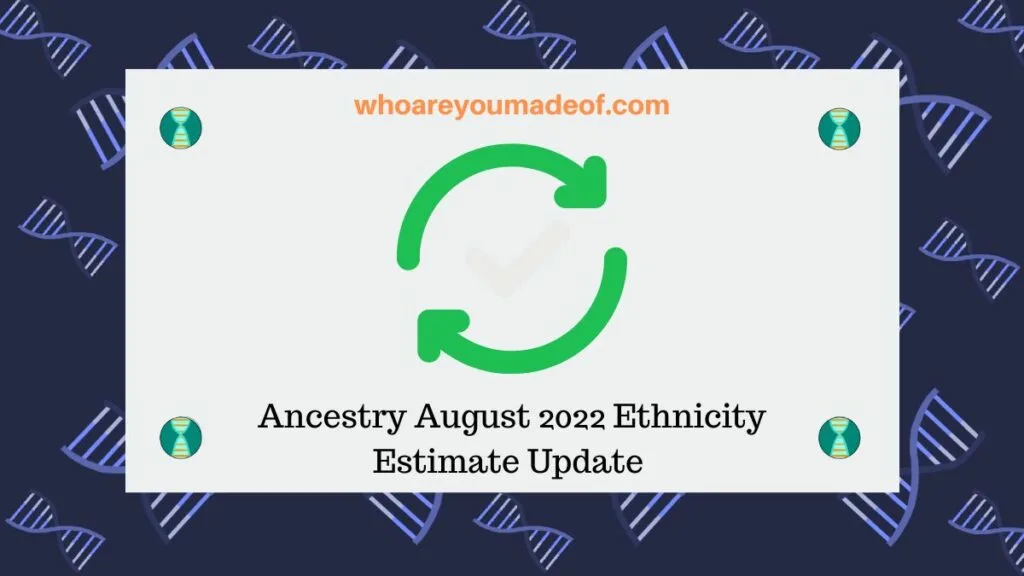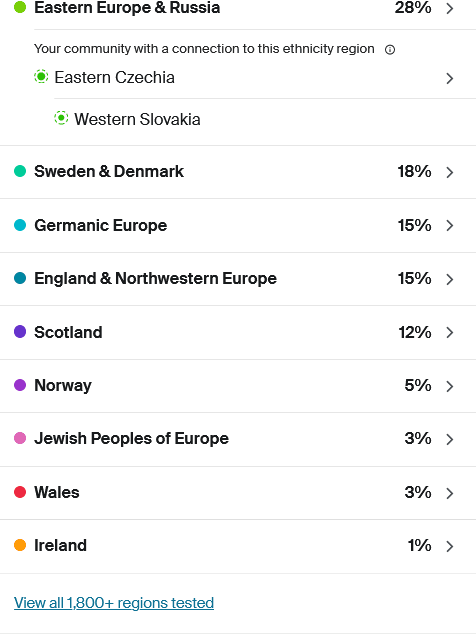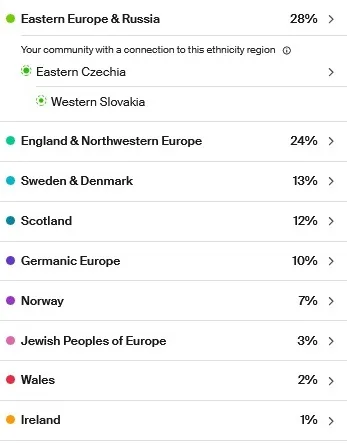Did your Ancestry DNA results get updated in August 2022? If so, you will definitely want to read this in-depth explanation of what changed in our ethnicity estimate results with this latest update.

If you are new to AncestryDNA, you might not know that your results will occasionally change as the science and technology improves. Even though there have been many technical advances in the field of using DNA for ancestry and genealogy, the field is still relatively new.
Ancestry updates ethnicity estimate results automatically for all current customers, even if the test that we took was years ago. We get to keep learning from our DNA test, which I think is pretty neat.
We generally see our Ancestry results go through a major update once a year, and occasionally see smaller updates, such as changes to Genetic or DNA Communities, throughout the year. Once the update begins rolling out, which it did on August 18, it might take a few days for everyone to see the newly calculated results.
We've also seen a few really cool new features added lately, such as the SideView Ethnicity Inheritance and Chromosome Painter.
On your ethnicity estimate, you can scroll down to the bottom of your list of regions to see the "Updated" date. If they have been updated, it should say "Updated August 2022", as opposed to the previous "Updated June 2022" date.
What changed with the Ancestry August 2022 update?
As always, this update promises to deliver more accurate ethnicity estimate results. The main elements of this update include several new regions, as well as accuracy improvements in many existing areas.
Our DNA is now compared to 1830 major regions, sub-regions, and DNA Communities around the world. It seems like an incredible number of regions compared to the 150 regions that were available when I first tested my DNA six years ago.
There were improvements, updates, and changes to regions in all six continent-level regions, so a large number of people should see at least minor adjustments to their estimate. If you have ancestry from one of the new regions added, you might see major changes because the algorithm will create your new estimate based on the new selection of available regions that best match your DNA.
While all improvements in accuracy are exciting and welcome by many customers, it is especially good to see the new regions added this year. Even if you don't have ancestry from the new regions that were added, I highly recommend checking back in with your Ancestry results to see if your results have gone through a recalculation with this new update.
Mine did, and I will show you an example towards the bottom of this article.
New regions added in August 2022
With the August 2022 update, there are a total of eight new regions Africa, Asia, and Oceania. These eight new regions are made up of two new regions for Africa, four for Asia, and the split of a region in Oceania.
New regions for Africa for this update:
- Nilotic Peoples
- Nigeria—East Central
Those with ancestry from Asia might also want to check their updated results to see if they have been matched with one of the four new sub-regions:
- Tibetan Peoples
- Southwestern China
- Central & Eastern China
- Nepal & the Himalayan Foothills
The total number of major regions, not counting sub-regions or communities, that we now see available on Ancestry is 84, compared to the previous 77 regions. These major regions often include country names, such as
What happened to the Eastern Polynesia and New Zealand Maori region
If you previously had the Oceania region that matched with Eastern Polynesia and New Zealand Maori, you might notice that this specific region no longer appears. Instead, there are now two more specific regions under Oceania:
- New Zealand Maori
- Hawaii
The addition of these two new regions, and the subtraction of one, brings the total number of Oceania ethnicity regions to eight. Oceania on Ancestry spans from Australia to as far north as Hawaii and as far south as New Zealand.
This large region includes many people with diverse cultures, so it is good that those with ancestors from this part of the world can now have access to more accurate and nuanced DNA results.
As an example from an Ancestry DNA test taken back in 2015; the test taker's ancestry from this region showed up as Polynesia. As their results became more specific, they saw their results progress through sub-regions and DNA Communities: Polynesian Islands > Hawaii Tonga & Samoa > Hawaii & New Zealand > both DNA Communities of New Zealand Maori and Hawaii.
Example of Ancestry results updated August 2022
Below is an example of my DNA results from both before and after the Ancestry DNA August 2022 update. As you can see, there were no major changes, but my percentages did shift for almost every region.
Only my Eastern Europe & Russia, Scotland, Ireland, and Jewish Peoples of Europe stayed the same. All of the other regions adjusted their percentages.


I can only interpret this to mean, at least for the time being, that Ancestry's algorithm is fairly confident about how much of my DNA matches each of these ethnicity regions. It makes sense, although I wonder if my Irish great-great grandfather knew that his ancestry was likely Scottish?
It will be interesting to see whether some of these other regions, such as the Germanic Europe, Sweden & Denmark, and England & Northwestern Europe, can be further refined over the course of time.
Conclusion
I hope that you learned all that you needed to know about your results that were updated in August of 2022. If you want to post a specific question or comment about something that you noticed from this latest iteration of your ethnicity estimate, please join in the discussion below.
It's always fun and interesting to see how our results evolve over time.
Thanks for reading today!

TC
Thursday 1st of September 2022
They waste too much on ethnicity meanwhile they cut corners on showing you actual dna matches and the shared matches that would actually help you find ancestors. I used to find clusters of matches with only 7 or 8 cM of DNA. Now I have matches with 20 to 30 cM with no shared matches all the time, so there is no way to figure out which parts of our families are related, much less trace to a common ancestor.
At this point I would not recommend any dna testing company unless you only care about the ethnicity. Ancestry is the only one with a large enough number of people to match against, but the number is so large now that apparently they can’t or won’t do the thorough matching like they used to.
As for the ethnicity estimates…
For a while I was 76% Irish 1% Scottish, 23% NorwaySweden/Baltic while they had my dad at 84% Irish and 16% Scottish. So it looked like I got none of his Scottish genes. And from my research I doubt he was more than 5%-10% Scottish.
Now it’s reversed. Im now 9% Scottish, which they tell me is all from my dad, but my dad is now only 4% Scottish. How can I possibly be twice as Scottish as the person I got the genes from?
CeeCee
Tuesday 30th of August 2022
I definitely agree... the results updates have been totally questionable & at times ridiculous! Since receiving my AncestryDNA results in 2015 my ancestry has literally jumped around the map of Europe & even Asia. I have lost more than 5 ethnicities & regained 1 ethnic group which I knew to be indisputable-- but getting it back took 2 years!
Also for over 2 years, I inherited 1 group at 70%-- all well and good-- but I have a well researched family tree & I know perfectly well my that both sides of the family are from totally different parts of Europe & do NOT share ethnicity. My mother is not Eastern European but N. Italian. My Dad is Eastern European BUT now he seems to share 10% of my mother's N. Italian on the latest update! Last update gave me Welsh. This update Welsh is replaced by Greek/Albanian?? Other lost ethnicities include: English, Irish, Swedish, Norwegian, & Finnish. Oddly, on 2 other sites, I have tons of close matches (20cm & up) with people from those groups. Some of these people are also on Ancestry where I have high matches but share absolutely no ethnicity with them.
I would absolutely love to know how I can share 142cm with someone but absolutely no ethnicity? That doesn't make any sense-- especially since we have shared matches that I know are close maternal cousins of mine.
Liz Davenport
Tuesday 30th of August 2022
I wonder whether AncestryDNA is still rolling out the August ethnicity updates -- although there were some adjustments (Scotland down from 27% to 15%!!), the date beneath my ethnicities list still reads June 2022. ??
Pat G.
Sunday 21st of August 2022
I fully understand ethnicity changes of a few percentages. However, my England ethnicity went from 19% in April, 2022 to 2% in July, 2022? And my granddaughter's England went from 23% in April to 4% in July. The larger percent sounds reasonable with maternal grandfather born in England, but I don't understand such a large drop in July.
Toni
Sunday 21st of August 2022
I rarely check this. Yes. It changes twice a year just like the clock. There is NO point in checking your ethnicity because it will only be good for 6 months and then it all changes again. Ten years ago I was German and English, just like my paper tree says. The last time I looked I was Russian and Sweden/Denmark. My sister who is my DNA match is German and Scot. Go figure. And so I don't pay any attention to their "updates".